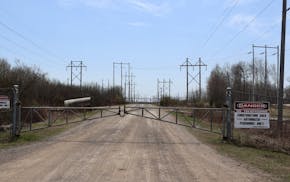The Twin Cities is no stranger to tornadoes.
In 1981, an F3 strength tornado traveled from Edina to Roseville, killing one person and injuring 83 more on its path. Another Minnesotan died three years later when a tornado tore through St. Anthony Village and New Brighton. A tornado struck south Minneapolis in 2009 and a second lashed north Minneapolis in 2011, killing two people.
But despite the evidence to the contrary, meteorologist Paul Douglas regularly encounters people who believe tornadoes are solely a rural threat, not an urban one. "I hear it all the time, people saying, 'I live in the metro and tornadoes don't hit here,'" said Douglas, who writes weather columns for the Minnesota Star Tribune.
Over the past week, two outbreaks of tornadoes pummeled states in the central United States, killing at least 28 people, including five in the city of St. Louis.
So why do so many Minnesotans believe that just because they live in a city, they're safe from tornadoes? The answer is a mix of fact and wishful thinking. Research shows the urban heat island effect can change tornado behavior, but meteorologists emphasize that cities are also vulnerable.
The Star Tribune spoke with weather experts, including some of the nation's leading researchers on urban tornadoes, to unpack the origins and of this conventional wisdom and separate truth from fiction.
Are cities less likely to be hit by tornadoes?
"The short answer is yes, cities change the local weather," said Dev Niyogi, a geosciences and engineering professor at the University of Texas at Austin and director of the school's extreme weather and urban sustainability lab.
Niyogi, who has studied urban tornadoes and other severe weather for more than a decade, said cities are often hotter than the rural regions surrounding them, creating pressure differences that can disrupt the conditions needed to form and sustain a tornado. Tall buildings, such as skyscrapers, can also act as physical barriers to some storm fronts, he added.
It's a phenomenon known as the "urban heat island effect." Because concrete and asphalt absorb the sun's heat better than grass, trees and lakes, urban landscapes are 1 to 7 degrees Fahrenheit warmer on average compared to rural areas, according to the U.S. Environmental Protection Agency. A 2024 temperature analysis of 65 major U.S. cities by the research group Climate Central found that Minneapolis is more than 8 degrees hotter on average compared to temperatures outside the metro area, with parts of downtown experiencing average temperatures exceeding 12 degrees.
As a result, tornadoes are slightly less likely to form over or pass through a city, especially downtown, compared to the suburbs and rural towns, Nigoyi said. His 2014 study, peer reviewed by the American Meteorological Society, found that when tornadoes touch down near urban areas, they tend to happen 1 to 10 miles from the city limits.
So are city dwellers safe from tornadoes?
Definitely not, Douglas said. To imply they are would be "disingenuous" and "dangerous."
Kenneth Blumenfeld, senior climatologist for the Minnesota Department of Natural Resources, said tornadoes "absolutely have" struck cities, including downtowns. Tornadoes hit the downtowns of U.S. cities, including Nashville, Atlanta and Miami, at least 20 times since 1950, according to the National Weather Service. The 2009 tornado that touched down in Minneapolis also reached downtown, dissipating near the Minneapolis Convention Center.
"That's why you want to take a tornado warning really seriously," Blumenfeld said.
Niyogi said there are limitations to how much an urban landscape can influence a passing storm system. Both the intensity of the storm and the intensity of the urban heat island effect play a role in that dynamic, he said. His research has shown that thunderstorms and tornadoes are less likely to form near cities at night, because heat islands tend to be more intense after the sun sets. Rural areas cool off faster than urban ones.
The bottom line is that if a storm is strong enough, the heat island effect won't make a difference, Douglas said. "I think everybody's looking for a magic cure, and living in a downtown does not make you immune from large tornadoes," he said.
So how did the narrative get skewed?
Scientists have theorized about urban heat islands and tornadoes since the early 1970s. Ted Fujita, the University of Chicago researcher responsible for the F-scale system for ranking tornado strength, was perhaps the most famous scientist to propose the theory.
Blumenfeld and Douglas believe the science over the years has largely been skewed by wishful thinking among the public.
Some studies have concluded that it's mostly chance that tornadoes rarely strike cities, since they make up such small targets relative to the rural areas around them. It's why the subject needs further study, Blumenfeld said. Nigoyi's research is at "the cutting edge" of the field, he said.
"If you look at all of the data, there are also some really weird patterns that we don't have explanations for," he said. "Why is it that the majority of tornadoes since the 1950s or '60s have occurred in the northwest half of the Twin Cities area? Is that just random chance, or is there something going on there?"

Amazon suspends Minnesota data center as lawmakers plan to reduce Big Tech tax breaks
Anderson: Punish poachers more
Before Gov. Walz tussled with Elon Musk, Tesla supercharged Minnesota's EV market

A massive development is proposed for a northeastern Minnesota city. Local officials aren't saying what it is.

